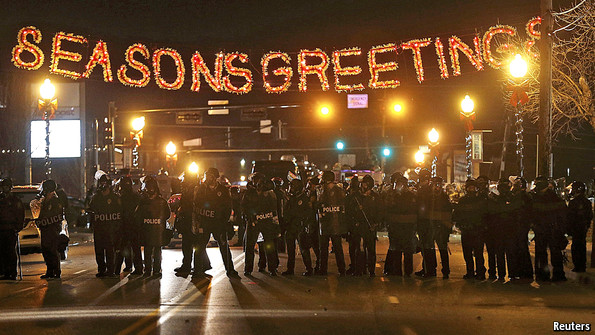We don’t belong here
Rioting in one run-down suburb of St Louis shows the enduring rift between blacks and the pólice
Nov 29th 2014
FERGUSON
.
“I AM Michael Brown’s uncle,” says a young man. “Will you donate money to my family?” He
turns out to be the younger brother of Lesley McSpadden, mother of the unarmed black teenager fatally sRhot earlier this year by a white police officer. He is standing in a group of people on the edge of West Florissant Road, next to a looted branch of McDonald’s, on the day after the worst riots since the unrest began after Mr Brown’s death in August. Because looting and arson were so bad along this stretch of highway, police had cordoned it off.
Asked why he should be given money, the young man says that he is suffering as a member of the Brown clan. He failed to get a job recently at the local casino because a member of staff told him that “white folks wouldn’t come” if they knew he worked there. “And she was black!” he exclaims.
A young woman standing nearby, who introduces herself as Kelsey, joins the conversation. The problem, she says, pointing at the scene of destruction from the night before, is that “we don’t belong here”. “We should have never come on those boats from Africa,” she sighs. She recounts how she is frequently stopped when she drives a relative’s car, which, she says, looks like a car only black people drive, with extended wheel arches. Recently she was stopped and asked whether she had any marijuana. She became agitated and said no, of course not. The police officer wrote out three tickets: one for tinted windows that were too dark, one for slowing down too much for a traffic light and one for disrespectful behaviour towards a law officer.
For blacks in this dilapidated suburb of St Louis, the killing of Mr Brown was the last straw in a history of mistreatment by the local police. They have long seen policemen, who are almost all white, as an occupying force. Stories abound of how the police in many towns of St Louis County systematically target black people for stops in traffic or on the street, imposing fines they often cannot pay and criminalising them for life. A report by ArchCity Defenders, a non-profit group, found that the municipal court in Ferguson—a city of 21,135 people—issued 32,975 arrest warrants last year, mostly for traffic violations. These fines and fees were the second-biggest source of the city’s $20m income.
The long-simmering anger of the black majority (Ferguson is 67% black) erupted again almost immediately after the announcement on the evening of November 24th of a grand jury’s decision that Darren Wilson, the police officer who shot Mr Brown, would not be charged.
More than a dozen businesses were set on fire and several others looted. According to the police, at least 150 gunshots were fired and several police cars torched. At times firefighters had to withdraw from battling fires because of the hail of gunfire, stones and other objects.
For the next night, November 25th, the governor of Missouri, Jay Nixon, called in more than 2,200 members of the National Guard, the reserve army, to protect homes and businesses. (The night before, around 700 members of the guard had been mainly deployed to protect government buildings and utilities.) Parts of West Florissant Road remained cordoned off. A police car was set on fire, 44 people were arrested and the police fired tear gas and smoke bombs to disperse crowds, but generally the protest was calmer and more controlled than on the previous night. In 170 cities across America, including New York and Los Angeles, people demonstrated largely peacefully to show solidarity with the people of Ferguson, chanting in protest against a law-enforcement system that seems heavily biased against people who are poor and non-white.
For Eugene O’Donnell, a former policeman-turned-lecturer at the John Jay College of Criminal Justice, the clumsy way Ferguson’s police handled Mr Brown’s shooting and its aftermath is symptomatic of larger problems of race, class and law enforcement in the country.
America’s police officers are often poorly paid and badly trained. In such a gun-infested society many resort to panicky, heavy-handed tactics, often picking on minorities, in their patrols of city streets. “Police departments are frequently not good at their core function,” says Mr O’Donnell. “Ferguson is not an outlier.”
Several recent incidents confirm this view. On November 20th a policeman in Brooklyn, New York shot and killed an unarmed black man in the stairwell of a housing project as he was leaving his girlfriend’s apartment. On November 23rd a policeman in Cleveland, Ohio fatally shot a 12-year-old black boy brandishing what turned out to be an air gun. (Police say it bore a close resemblance to a semi-automatic pistol.) Blacks are killed at troubling rates compared with whites. According to ProPublica, a website for investigative journalism, between 2010 and 2012 young black males were 21 times more likely to be fatally shot by police than white men in the same age range.
“Communities of colour aren’t just making these problems up,” observed President Barack Obama in a late-night briefing after the announcement of the decision of the jury in Ferguson.
The many ills of poor, shrinking and largely black rustbelt cities will take a long time to fix. But more accountable policing is a step that is relatively easy to take. Body-mounted cameras for policemen, which Mr Brown’s parents want to make a requirement in memory of their son, are a good idea. Had Mr Wilson worn such a camera, Americans would know what happened just before he shot Mr Brown. As it is, many people in Ferguson remain unconvinced that he acted lawfully; and so the old wound will continue to fester.

0 comments:
Publicar un comentario